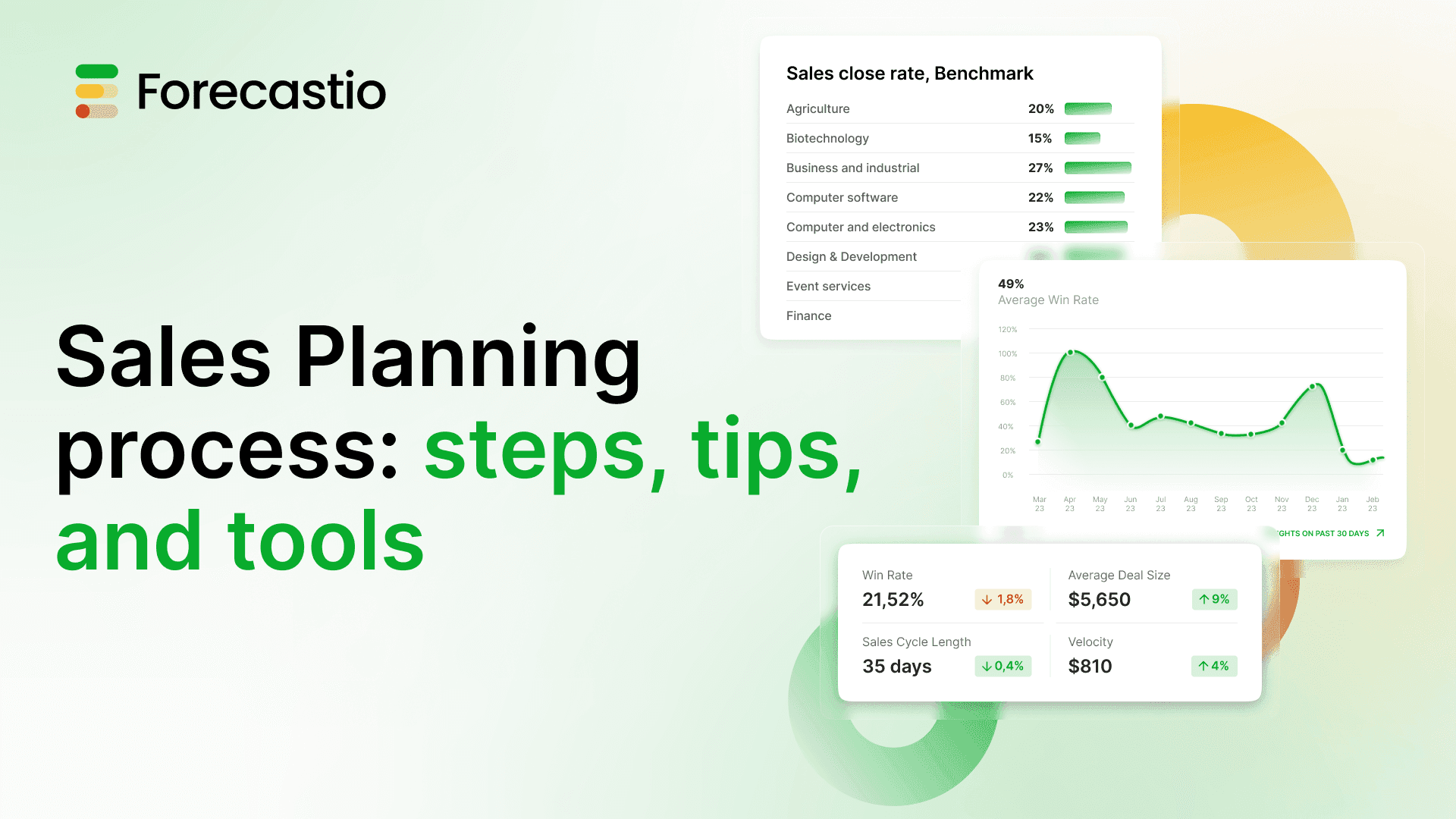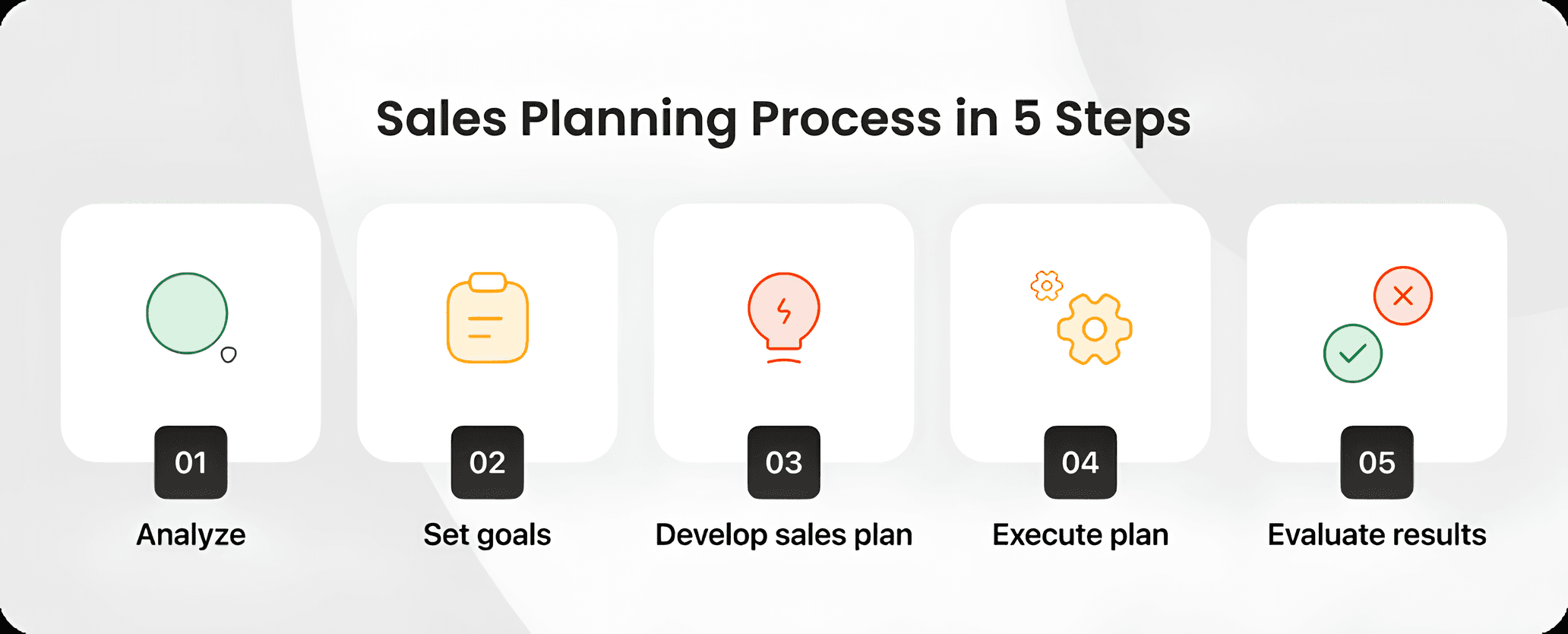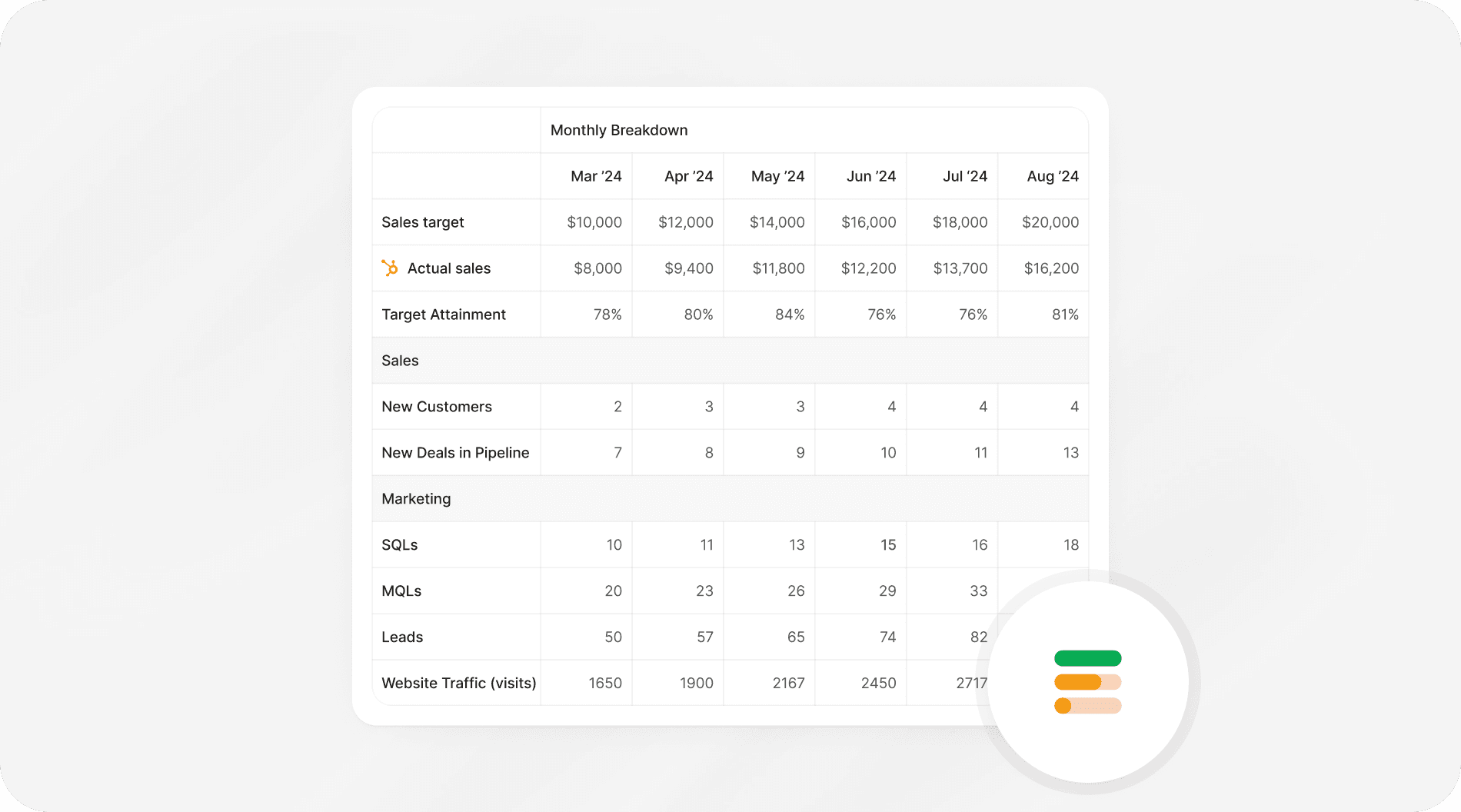
Master the Sales Planning Process: Steps, Tips, and Tools
May 20, 2025
May 20, 2025

Alex Zlotko
CEO at Forecastio
Last updated
May 20, 2025
Reading time
18 min
Share:
Share
Table of Contents




TL;DR
TL;DR
The Impact of Strategic Sales Planning:
Companies with structured sales planning are 33% more likely to hit revenue targets
Organizations using data-driven sales tools grow 19% faster and close 31% more deals
Effective planning reduces forecast variance by up to 26% and shortens sales cycles by 15%
Master Your Sales Planning in 5 Steps:
Assess Performance - Analyze past data and conduct SWOT analysis
Define Target Audience - Create detailed ICPs and buyer personas
Set SMART Goals - Establish measurable objectives aligned with business strategy
Develop Sales Tactics - Choose optimal inbound/outbound mix for each segment
Implement & Monitor - Deploy the right tools and continuously track KPIs
Why Act Now: Without structured sales planning, teams experience 42% higher turnover, 38% less accurate forecasts, and 27% longer sales cycles.
The Impact of Strategic Sales Planning:
Companies with structured sales planning are 33% more likely to hit revenue targets
Organizations using data-driven sales tools grow 19% faster and close 31% more deals
Effective planning reduces forecast variance by up to 26% and shortens sales cycles by 15%
Master Your Sales Planning in 5 Steps:
Assess Performance - Analyze past data and conduct SWOT analysis
Define Target Audience - Create detailed ICPs and buyer personas
Set SMART Goals - Establish measurable objectives aligned with business strategy
Develop Sales Tactics - Choose optimal inbound/outbound mix for each segment
Implement & Monitor - Deploy the right tools and continuously track KPIs
Why Act Now: Without structured sales planning, teams experience 42% higher turnover, 38% less accurate forecasts, and 27% longer sales cycles.
What is Sales Planning?
Sales planning is a strategic process that aligns your sales activities with broader business objectives. It bridges the gap between high-level aspirations and day-to-day sales operations, creating a roadmap that guides teams toward sustainable growth.
Effective sales planning ensures every sales activity directly contributes to organizational goals, whether market expansion, product launches, or increased market share. According to Forrester research, highly aligned companies grow 19% faster and are 15% more profitable than those operating without proper alignment.
The Real Cost of Poor Sales Planning
McKinsey's 2024 Sales Excellence Report found that companies with inconsistent sales planning processes experience:
42% higher sales team turnover
38% less accurate forecasts
27% longer sales cycles
23% lower quota attainment rates
See how Forecastio can solve these challenges →
The 5-Step Sales Planning Process Framework

Step 1: Assess Current Sales Performance
Analyze Past Performance Data
The sales planning process begins with a thorough analysis of historical sales data to understand trends, patterns, and outcomes. Key metrics to consider include:
Total sales volume
Sales velocity
Average deal size
Sales rep ramp-up periods
Customer acquisition costs
Conversion rates
Sales cycle length
This analysis establishes benchmarks against previous periods and lays the foundation for setting realistic future goals in your sales planning process.
Identify Strengths, Weaknesses, Opportunities, and Threats
With data in hand, conduct a comprehensive SWOT analysis of your sales operations:
Strengths: High-performing team members, strong brand reputation, proprietary technology
Weaknesses: Inefficient lead generation, high customer churn, product-market fit challenges
Opportunities: Emerging market trends, new technology adoption, competitor weaknesses
Threats: New market entrants, changing customer preferences, economic shifts
This assessment goes beyond identifying what's working or failing—it uncovers why. For instance, high customer churn might stem from product issues, customer service shortfalls, or an ineffective sales strategy. Understanding these underlying factors enables targeted improvements in your sales planning.
Practical Implementation:
Gather comprehensive sales data using CRM tools and sales performance management software
Conduct collaborative performance reviews with sales leaders and team members
Identify patterns and seasonal trends in your sales data
Collect qualitative feedback from sales reps and customers
Develop a focused action plan addressing identified weaknesses
"Before Forecastio, our performance analysis was like looking through a foggy window. Now we have crystal-clear visibility into what's actually driving our sales success." — Jamie Cortez, VP of Sales

Step 2: Define Your Ideal Customer Profile
Understanding your target audience is pivotal for developing effective sales strategies. As Max Altschuler, General Partner at GTMfund, notes: "Your ICP doesn't need to be perfect, but you at least need to have one before hiring a sales team. Narrowing this will give your sales team a clear demographic to target."
Understand Your Target Market
The target market comprises individuals or organizations most likely to purchase your product or service. Identifying this group involves analyzing market segments based on demographics, location, industry (for B2B sales), and psychographics.
Key considerations include:
Market size and growth potential
Customer needs and pain points
Competitive landscape and positioning
Purchase decision drivers
Create Detailed Buyer Personas
Buyer personas are fictional representations of your ideal customers that help visualize the target audience and make sales planning more concrete. Effective buyer personas include:
Demographic information (age, gender, location, job title, income level)
Behavioral traits (buying patterns, product usage, service preferences)
Motivations and challenges (goals, pain points, desired solutions)
Decision-making process (evaluation criteria, potential objections, influencing factors)
Practical Implementation:
Conduct market research through surveys, interviews, and online behavior analysis
Segment your market based on relevant criteria for targeted sales planning
Organize workshops with stakeholders to develop comprehensive buyer personas
Regularly review and update personas based on evolving market conditions
Step 3: Set Clear Sales Goals
After assessing performance and defining your target audience, setting clear, achievable sales goals is the next critical step in the sales planning process. These goals drive sales team efforts and align with organizational objectives.
Define SMART Objectives
Effective sales planning requires goals that are Specific, Measurable, Achievable, Relevant, and Time-bound:
Specific: Instead of "increase sales," specify "increase Product X sales by 15% in Q2"
Measurable: Include quantifiable metrics to track progress
Achievable: Set challenging but realistic targets to avoid demoralizing your team
Relevant: Ensure goals align with broader business objectives
Time-bound: Establish clear deadlines to create urgency and prioritization

Align Sales Goals with Business Strategy
Strategic alignment ensures relevance and success in your sales planning:
Collaborate across departments (leadership, marketing, product, customer service)
Analyze market conditions and competitive landscape
Implement flexible goal-setting to adapt to market changes and internal shifts
Base sales quotas on historical data and objective analysis
As Scott Leese, CEO of Surf and Sales, cautions: "Quota is a joke at too many companies and a fantasy at others." Avoid this pitfall by grounding your sales planning in reliable data.
Practical Implementation:
Organize sales planning workshops with leaders and department heads
Use historical data, industry benchmarks, and market research for informed goal-setting
When increasing quotas, demonstrate the data-backed reasoning behind the decision
Clearly communicate finalized goals to the entire sales team and stakeholders
Forecastio Feature Spotlight: Our goal-setting module applies AI-driven analysis to your historical performance data, suggesting realistic targets based on industry benchmarks, market conditions, and team capacity. This eliminates guesswork and creates attainable, motivating goals.
Try our Sales Goal Attainment Calculator →
Step 4: Develop Strategic Sales Tactics
With a clear understanding of your target market and concrete goals, the next step in your sales planning process is developing effective sales strategies and tactics.
Choose Between Inbound and Outbound Approaches
Inbound Sales Strategy focuses on attracting customers through valuable content using channels like SEO, blogs, social media, and email marketing. This approach establishes your brand as a trusted resource, drawing potential customers to you.
Advantages:
Builds long-term customer relationships
Offers excellent cost efficiency
Aligns with modern buyer behaviors
Key Tactics:
Content marketing
SEO optimization
Social media engagement
Webinars and educational material
Nurture campaigns
Outbound Sales Strategy involves proactive outreach to potential customers through calls, emails, direct mail, and networking events. This approach initiates first contact to pitch your value proposition.
Advantages:
Provides direct control over the sales process
Generates immediate feedback
Quickly gauges market interest
Key Tactics:
Multi-channel outreach (email, LinkedIn, calls)
Targeted account-based marketing
Industry events and conferences
Direct mail campaigns

Customize Approaches for Different Customer Segments
Tailoring your sales tactics to each customer segment's specific needs significantly enhances effectiveness:
Leverage buyer personas to personalize communications
Develop segment-specific value propositions addressing unique pain points
Identify preferred communication channels for each segment
Create customized sales materials reflecting segment-specific interests and concerns
Practical Implementation:
Conduct strategy selection workshops with sales and marketing teams
Develop a comprehensive sales playbook outlining strategies for each segment
Provide tailored training and role-playing exercises for your sales team
Continuously monitor strategy effectiveness through metrics and feedback
"Implementing hybrid sales strategies through Forecastio increased our enterprise deal close rate by 36% in just one quarter." — Michael Rivera, Director of Sales Strategy
Step 5: Select Tools and Implement Your Plan
The final phase of the sales planning process involves selecting the right tools, creating detailed execution plans, and establishing monitoring systems.
Choose Effective Sales Planning Tools
The right technology stack can dramatically improve your sales planning process and execution:
CRM Systems: The foundation of sales operations, enabling relationship management and interaction tracking. Look for:
Contact and lead management features
Integration capabilities with other tools
Customizable reporting dashboards
Mobile accessibility
Comprehensive pipeline management
Sales Performance Management Platforms: These extend beyond CRM to assist with sales planning, forecasting, trend analysis, and bottleneck detection. According to LinkedIn's 2024 State of Sales Report, 77% of sales professionals say their company plans to invest more heavily in sales intelligence tools.
Sales Automation Tools: These streamline repetitive tasks, freeing sales reps to focus on relationship building and closing deals.
Analytics Platforms: These provide deep insights into sales performance, customer behavior, and market trends.
Compare: Manual Sales Planning vs. Forecastio Platform
Planning Aspect | Manual Planning | Forecastio Platform |
|---|---|---|
Time Investment | 40+ hours per quarter | 4-6 hours per quarter |
Forecast Accuracy | Typically 60-70% | 85-95% proven accuracy |
Data Integration | Manual data collection and reconciliation | Automatic integration with HubSpot CRM and other systems |
Real-time Updates | Requires manual updates | Dynamic, real-time plan adjustments |
Scenario Planning | Limited, time-consuming | Instant "what-if" analysis for multiple scenarios |
Visibility | Siloed information | Complete transparency across departments |
Team Alignment | Misalignment common | Built-in collaboration tools ensure alignment |
Resource Optimization | Based on intuition | AI-driven resource allocation recommendations |
Create a Detailed Implementation Plan
Structure your plan with clear timelines, responsibilities, and targets:
Establish Clear Timelines: Define when each goal should be achieved, providing structure and urgency.
Assign Specific Responsibilities: Clearly define who handles each task for accountability and teamwork.
Break Goals into Action Items: Divide larger objectives into manageable steps with clear execution paths.
Define Key Performance Indicators: Identify specific metrics to measure success.
Incorporate Sales Forecasts: Base projections on historical data, market analysis, and future conditions.
Monitor and Adjust Continuously
Effective sales planning is an ongoing, iterative process:
Regular Performance Reviews: Schedule consistent data analysis sessions against KPIs.
Leverage Analytics Tools: Use CRM and specialized software to gather actionable insights.
Identify Patterns: Look for signals indicating successes or challenges in your sales planning execution.
Make Data-Driven Adjustments: Update strategies based on performance data and market changes.
Foster Stakeholder Involvement: Engage all relevant teams in the review process.
Practical Implementation:
Develop implementation checklists covering all sales planning elements
Create a culture of data-driven decision-making
Schedule regular workshops to discuss monitoring results
Implement recognition systems to celebrate achievements and provide constructive feedback
See Forecastio's sales planning in action →
Sales Planning Best Practices
To maximize the impact of your sales planning process, incorporate these proven strategies:
Align Sales and Marketing Teams
Involve both departments in collaborative goal-setting
Establish shared metrics and KPIs for joint accountability
Schedule regular alignment meetings for updates and strategy coordination
Focus on Customer Relationship Management
Develop deep understanding of customer needs and preferences using CRM tools
Personalize communications based on customer data
Prioritize long-term relationships over quick transactions
Implement regular follow-ups and provide valuable content
Adapt to Market Dynamics
Stay informed about industry trends and competitive movements
Experiment with innovative sales approaches and technologies
Maintain flexibility to pivot strategies as opportunities or challenges arise
Leverage Data-Driven Insights
Base all sales planning decisions on robust data analysis
Track key metrics daily: total sales, pipeline growth, close rates, deal size, and acquisition costs
Implement regular forecast reviews and adjustments
Use predictive analytics to identify future opportunities
"The data visualization capabilities in Forecastio helped us identify a critical bottleneck in our sales process that was costing us $1.8M annually. We fixed it within weeks." — Sophia Washington, Sales Operations Director
Essential Sales Planning Tools
Choosing the right tools can dramatically enhance your sales planning process effectiveness:
CRM Systems
Popular options include HubSpot, Salesforce, and Zoho CRM, offering centralized platforms for managing customer interactions and sales processes.
Sales Performance Management Platforms
Solutions like Forecastio, Clari, and BoostUp provide comprehensive visibility into sales operations and forecasting. Learn more about how Forecastio compares to alternatives like Clari in our detailed analysis.
Sales Automation Tools
Platforms such as Outreach, SalesLoft, and Reply automate repetitive tasks from prospecting to nurturing.
Analytics Platforms
Tools like Google Analytics, Tableau, and Microsoft Power BI deliver insights into performance, behavior, and trends.
Companies that deployed comprehensive RevOps platforms grew revenue 3x faster than those relying on disconnected systems, according to Forrester's 2025 Revenue Operations Benchmark Report.
Compare top sales planning tools →
Real-World Example
When enterprise software company implemented a structured sales planning process using Forecastio, they faced three critical challenges:
Misalignment between marketing and sales forecasts
Unrealistic quota setting causing team burnout
Inability to accurately predict quarterly performance
Their 5-step implementation included:
Assessment: Analyzed 18 months of CRM data to identify a 22% gap between forecasts and results
ICP Refinement: Narrowed target accounts from 12 to 3 key industries based on conversion data
Goal Setting: Implemented data-driven quotas with 15% stretch goals based on historical performance
Strategy Development: Created separate approaches for enterprise (outbound) and mid-market (inbound) segments
Tool Implementation: Deployed Forecastio to centralize planning and monitoring
Results:
Forecast accuracy improved from 65% to 91%
Sales team retention increased by 24%
Revenue predictability enabled more strategic resource allocation
"The structured sales planning process gave us visibility we never had before," says Sarah Chen, VP of Sales. "Now we can confidently predict our quarter and make data-driven decisions that actually increase win rates."

Frequently Asked Questions About Sales Planning
What is the difference between sales planning and sales forecasting?
While closely related, sales planning is the strategic process of determining how to achieve business objectives through sales activities, while sales forecasting is specifically focused on predicting future sales volumes and revenue. Sales planning incorporates forecasting as one of its components. Learn more in our detailed guide on sales planning vs. forecasting.
How often should a sales plan be updated?
Best practice is to review and adjust sales plans quarterly, with monthly check-ins to monitor progress and make tactical adjustments. However, in rapidly changing markets, more frequent reviews may be necessary. The key is establishing a consistent rhythm while maintaining flexibility to adapt to market shifts.
What are the two tasks that occur during the sales plan formulation process?
The two primary tasks are (1) analyzing historical performance data to establish baselines and identify trends, and (2) setting forward-looking objectives and strategies based on this analysis, market conditions, and overall business goals.
What are the components of an effective sales plan?
A comprehensive sales plan includes market analysis, customer segmentation, revenue targets, action strategies, resource allocation, timeline, budget, KPIs, and monitoring mechanisms. Each component should be data-driven and aligned with overall business objectives.
How can I improve my sales planning process?
Improvement starts with comprehensive data analysis, cross-functional collaboration, realistic goal-setting, and leveraging modern sales planning tools. Forecastio's planning platform can dramatically enhance your planning efficiency with AI-driven insights, centralized data, and automated workflows.
Conclusion: Transform Your Sales Approach
Effective sales planning is the cornerstone of sustainable revenue growth. By implementing the five-step sales planning process outlined in this guide, you'll create alignment between sales activities and business goals, optimize resource allocation, and adapt more effectively to market changes.
Remember that sales planning is not a one-time event but an ongoing strategic process. Organizations that commit to continuous improvement in their sales planning process consistently outperform competitors and achieve sustainable growth.
Ready to transform your sales approach? Begin by assessing your current performance, clearly defining your target audience, setting data-driven goals, developing tailored strategies, and implementing with the right tools.
Transform your sales planning today! Book a 30-minute demo →
Our experts will show you how Forecastio can help you implement a data-driven sales planning process that increases forecast accuracy, aligns your teams, and drives predictable revenue growth.
What is Sales Planning?
Sales planning is a strategic process that aligns your sales activities with broader business objectives. It bridges the gap between high-level aspirations and day-to-day sales operations, creating a roadmap that guides teams toward sustainable growth.
Effective sales planning ensures every sales activity directly contributes to organizational goals, whether market expansion, product launches, or increased market share. According to Forrester research, highly aligned companies grow 19% faster and are 15% more profitable than those operating without proper alignment.
The Real Cost of Poor Sales Planning
McKinsey's 2024 Sales Excellence Report found that companies with inconsistent sales planning processes experience:
42% higher sales team turnover
38% less accurate forecasts
27% longer sales cycles
23% lower quota attainment rates
See how Forecastio can solve these challenges →
The 5-Step Sales Planning Process Framework

Step 1: Assess Current Sales Performance
Analyze Past Performance Data
The sales planning process begins with a thorough analysis of historical sales data to understand trends, patterns, and outcomes. Key metrics to consider include:
Total sales volume
Sales velocity
Average deal size
Sales rep ramp-up periods
Customer acquisition costs
Conversion rates
Sales cycle length
This analysis establishes benchmarks against previous periods and lays the foundation for setting realistic future goals in your sales planning process.
Identify Strengths, Weaknesses, Opportunities, and Threats
With data in hand, conduct a comprehensive SWOT analysis of your sales operations:
Strengths: High-performing team members, strong brand reputation, proprietary technology
Weaknesses: Inefficient lead generation, high customer churn, product-market fit challenges
Opportunities: Emerging market trends, new technology adoption, competitor weaknesses
Threats: New market entrants, changing customer preferences, economic shifts
This assessment goes beyond identifying what's working or failing—it uncovers why. For instance, high customer churn might stem from product issues, customer service shortfalls, or an ineffective sales strategy. Understanding these underlying factors enables targeted improvements in your sales planning.
Practical Implementation:
Gather comprehensive sales data using CRM tools and sales performance management software
Conduct collaborative performance reviews with sales leaders and team members
Identify patterns and seasonal trends in your sales data
Collect qualitative feedback from sales reps and customers
Develop a focused action plan addressing identified weaknesses
"Before Forecastio, our performance analysis was like looking through a foggy window. Now we have crystal-clear visibility into what's actually driving our sales success." — Jamie Cortez, VP of Sales

Step 2: Define Your Ideal Customer Profile
Understanding your target audience is pivotal for developing effective sales strategies. As Max Altschuler, General Partner at GTMfund, notes: "Your ICP doesn't need to be perfect, but you at least need to have one before hiring a sales team. Narrowing this will give your sales team a clear demographic to target."
Understand Your Target Market
The target market comprises individuals or organizations most likely to purchase your product or service. Identifying this group involves analyzing market segments based on demographics, location, industry (for B2B sales), and psychographics.
Key considerations include:
Market size and growth potential
Customer needs and pain points
Competitive landscape and positioning
Purchase decision drivers
Create Detailed Buyer Personas
Buyer personas are fictional representations of your ideal customers that help visualize the target audience and make sales planning more concrete. Effective buyer personas include:
Demographic information (age, gender, location, job title, income level)
Behavioral traits (buying patterns, product usage, service preferences)
Motivations and challenges (goals, pain points, desired solutions)
Decision-making process (evaluation criteria, potential objections, influencing factors)
Practical Implementation:
Conduct market research through surveys, interviews, and online behavior analysis
Segment your market based on relevant criteria for targeted sales planning
Organize workshops with stakeholders to develop comprehensive buyer personas
Regularly review and update personas based on evolving market conditions
Step 3: Set Clear Sales Goals
After assessing performance and defining your target audience, setting clear, achievable sales goals is the next critical step in the sales planning process. These goals drive sales team efforts and align with organizational objectives.
Define SMART Objectives
Effective sales planning requires goals that are Specific, Measurable, Achievable, Relevant, and Time-bound:
Specific: Instead of "increase sales," specify "increase Product X sales by 15% in Q2"
Measurable: Include quantifiable metrics to track progress
Achievable: Set challenging but realistic targets to avoid demoralizing your team
Relevant: Ensure goals align with broader business objectives
Time-bound: Establish clear deadlines to create urgency and prioritization

Align Sales Goals with Business Strategy
Strategic alignment ensures relevance and success in your sales planning:
Collaborate across departments (leadership, marketing, product, customer service)
Analyze market conditions and competitive landscape
Implement flexible goal-setting to adapt to market changes and internal shifts
Base sales quotas on historical data and objective analysis
As Scott Leese, CEO of Surf and Sales, cautions: "Quota is a joke at too many companies and a fantasy at others." Avoid this pitfall by grounding your sales planning in reliable data.
Practical Implementation:
Organize sales planning workshops with leaders and department heads
Use historical data, industry benchmarks, and market research for informed goal-setting
When increasing quotas, demonstrate the data-backed reasoning behind the decision
Clearly communicate finalized goals to the entire sales team and stakeholders
Forecastio Feature Spotlight: Our goal-setting module applies AI-driven analysis to your historical performance data, suggesting realistic targets based on industry benchmarks, market conditions, and team capacity. This eliminates guesswork and creates attainable, motivating goals.
Try our Sales Goal Attainment Calculator →
Step 4: Develop Strategic Sales Tactics
With a clear understanding of your target market and concrete goals, the next step in your sales planning process is developing effective sales strategies and tactics.
Choose Between Inbound and Outbound Approaches
Inbound Sales Strategy focuses on attracting customers through valuable content using channels like SEO, blogs, social media, and email marketing. This approach establishes your brand as a trusted resource, drawing potential customers to you.
Advantages:
Builds long-term customer relationships
Offers excellent cost efficiency
Aligns with modern buyer behaviors
Key Tactics:
Content marketing
SEO optimization
Social media engagement
Webinars and educational material
Nurture campaigns
Outbound Sales Strategy involves proactive outreach to potential customers through calls, emails, direct mail, and networking events. This approach initiates first contact to pitch your value proposition.
Advantages:
Provides direct control over the sales process
Generates immediate feedback
Quickly gauges market interest
Key Tactics:
Multi-channel outreach (email, LinkedIn, calls)
Targeted account-based marketing
Industry events and conferences
Direct mail campaigns

Customize Approaches for Different Customer Segments
Tailoring your sales tactics to each customer segment's specific needs significantly enhances effectiveness:
Leverage buyer personas to personalize communications
Develop segment-specific value propositions addressing unique pain points
Identify preferred communication channels for each segment
Create customized sales materials reflecting segment-specific interests and concerns
Practical Implementation:
Conduct strategy selection workshops with sales and marketing teams
Develop a comprehensive sales playbook outlining strategies for each segment
Provide tailored training and role-playing exercises for your sales team
Continuously monitor strategy effectiveness through metrics and feedback
"Implementing hybrid sales strategies through Forecastio increased our enterprise deal close rate by 36% in just one quarter." — Michael Rivera, Director of Sales Strategy
Step 5: Select Tools and Implement Your Plan
The final phase of the sales planning process involves selecting the right tools, creating detailed execution plans, and establishing monitoring systems.
Choose Effective Sales Planning Tools
The right technology stack can dramatically improve your sales planning process and execution:
CRM Systems: The foundation of sales operations, enabling relationship management and interaction tracking. Look for:
Contact and lead management features
Integration capabilities with other tools
Customizable reporting dashboards
Mobile accessibility
Comprehensive pipeline management
Sales Performance Management Platforms: These extend beyond CRM to assist with sales planning, forecasting, trend analysis, and bottleneck detection. According to LinkedIn's 2024 State of Sales Report, 77% of sales professionals say their company plans to invest more heavily in sales intelligence tools.
Sales Automation Tools: These streamline repetitive tasks, freeing sales reps to focus on relationship building and closing deals.
Analytics Platforms: These provide deep insights into sales performance, customer behavior, and market trends.
Compare: Manual Sales Planning vs. Forecastio Platform
Planning Aspect | Manual Planning | Forecastio Platform |
|---|---|---|
Time Investment | 40+ hours per quarter | 4-6 hours per quarter |
Forecast Accuracy | Typically 60-70% | 85-95% proven accuracy |
Data Integration | Manual data collection and reconciliation | Automatic integration with HubSpot CRM and other systems |
Real-time Updates | Requires manual updates | Dynamic, real-time plan adjustments |
Scenario Planning | Limited, time-consuming | Instant "what-if" analysis for multiple scenarios |
Visibility | Siloed information | Complete transparency across departments |
Team Alignment | Misalignment common | Built-in collaboration tools ensure alignment |
Resource Optimization | Based on intuition | AI-driven resource allocation recommendations |
Create a Detailed Implementation Plan
Structure your plan with clear timelines, responsibilities, and targets:
Establish Clear Timelines: Define when each goal should be achieved, providing structure and urgency.
Assign Specific Responsibilities: Clearly define who handles each task for accountability and teamwork.
Break Goals into Action Items: Divide larger objectives into manageable steps with clear execution paths.
Define Key Performance Indicators: Identify specific metrics to measure success.
Incorporate Sales Forecasts: Base projections on historical data, market analysis, and future conditions.
Monitor and Adjust Continuously
Effective sales planning is an ongoing, iterative process:
Regular Performance Reviews: Schedule consistent data analysis sessions against KPIs.
Leverage Analytics Tools: Use CRM and specialized software to gather actionable insights.
Identify Patterns: Look for signals indicating successes or challenges in your sales planning execution.
Make Data-Driven Adjustments: Update strategies based on performance data and market changes.
Foster Stakeholder Involvement: Engage all relevant teams in the review process.
Practical Implementation:
Develop implementation checklists covering all sales planning elements
Create a culture of data-driven decision-making
Schedule regular workshops to discuss monitoring results
Implement recognition systems to celebrate achievements and provide constructive feedback
See Forecastio's sales planning in action →
Sales Planning Best Practices
To maximize the impact of your sales planning process, incorporate these proven strategies:
Align Sales and Marketing Teams
Involve both departments in collaborative goal-setting
Establish shared metrics and KPIs for joint accountability
Schedule regular alignment meetings for updates and strategy coordination
Focus on Customer Relationship Management
Develop deep understanding of customer needs and preferences using CRM tools
Personalize communications based on customer data
Prioritize long-term relationships over quick transactions
Implement regular follow-ups and provide valuable content
Adapt to Market Dynamics
Stay informed about industry trends and competitive movements
Experiment with innovative sales approaches and technologies
Maintain flexibility to pivot strategies as opportunities or challenges arise
Leverage Data-Driven Insights
Base all sales planning decisions on robust data analysis
Track key metrics daily: total sales, pipeline growth, close rates, deal size, and acquisition costs
Implement regular forecast reviews and adjustments
Use predictive analytics to identify future opportunities
"The data visualization capabilities in Forecastio helped us identify a critical bottleneck in our sales process that was costing us $1.8M annually. We fixed it within weeks." — Sophia Washington, Sales Operations Director
Essential Sales Planning Tools
Choosing the right tools can dramatically enhance your sales planning process effectiveness:
CRM Systems
Popular options include HubSpot, Salesforce, and Zoho CRM, offering centralized platforms for managing customer interactions and sales processes.
Sales Performance Management Platforms
Solutions like Forecastio, Clari, and BoostUp provide comprehensive visibility into sales operations and forecasting. Learn more about how Forecastio compares to alternatives like Clari in our detailed analysis.
Sales Automation Tools
Platforms such as Outreach, SalesLoft, and Reply automate repetitive tasks from prospecting to nurturing.
Analytics Platforms
Tools like Google Analytics, Tableau, and Microsoft Power BI deliver insights into performance, behavior, and trends.
Companies that deployed comprehensive RevOps platforms grew revenue 3x faster than those relying on disconnected systems, according to Forrester's 2025 Revenue Operations Benchmark Report.
Compare top sales planning tools →
Real-World Example
When enterprise software company implemented a structured sales planning process using Forecastio, they faced three critical challenges:
Misalignment between marketing and sales forecasts
Unrealistic quota setting causing team burnout
Inability to accurately predict quarterly performance
Their 5-step implementation included:
Assessment: Analyzed 18 months of CRM data to identify a 22% gap between forecasts and results
ICP Refinement: Narrowed target accounts from 12 to 3 key industries based on conversion data
Goal Setting: Implemented data-driven quotas with 15% stretch goals based on historical performance
Strategy Development: Created separate approaches for enterprise (outbound) and mid-market (inbound) segments
Tool Implementation: Deployed Forecastio to centralize planning and monitoring
Results:
Forecast accuracy improved from 65% to 91%
Sales team retention increased by 24%
Revenue predictability enabled more strategic resource allocation
"The structured sales planning process gave us visibility we never had before," says Sarah Chen, VP of Sales. "Now we can confidently predict our quarter and make data-driven decisions that actually increase win rates."

Frequently Asked Questions About Sales Planning
What is the difference between sales planning and sales forecasting?
While closely related, sales planning is the strategic process of determining how to achieve business objectives through sales activities, while sales forecasting is specifically focused on predicting future sales volumes and revenue. Sales planning incorporates forecasting as one of its components. Learn more in our detailed guide on sales planning vs. forecasting.
How often should a sales plan be updated?
Best practice is to review and adjust sales plans quarterly, with monthly check-ins to monitor progress and make tactical adjustments. However, in rapidly changing markets, more frequent reviews may be necessary. The key is establishing a consistent rhythm while maintaining flexibility to adapt to market shifts.
What are the two tasks that occur during the sales plan formulation process?
The two primary tasks are (1) analyzing historical performance data to establish baselines and identify trends, and (2) setting forward-looking objectives and strategies based on this analysis, market conditions, and overall business goals.
What are the components of an effective sales plan?
A comprehensive sales plan includes market analysis, customer segmentation, revenue targets, action strategies, resource allocation, timeline, budget, KPIs, and monitoring mechanisms. Each component should be data-driven and aligned with overall business objectives.
How can I improve my sales planning process?
Improvement starts with comprehensive data analysis, cross-functional collaboration, realistic goal-setting, and leveraging modern sales planning tools. Forecastio's planning platform can dramatically enhance your planning efficiency with AI-driven insights, centralized data, and automated workflows.
Conclusion: Transform Your Sales Approach
Effective sales planning is the cornerstone of sustainable revenue growth. By implementing the five-step sales planning process outlined in this guide, you'll create alignment between sales activities and business goals, optimize resource allocation, and adapt more effectively to market changes.
Remember that sales planning is not a one-time event but an ongoing strategic process. Organizations that commit to continuous improvement in their sales planning process consistently outperform competitors and achieve sustainable growth.
Ready to transform your sales approach? Begin by assessing your current performance, clearly defining your target audience, setting data-driven goals, developing tailored strategies, and implementing with the right tools.
Transform your sales planning today! Book a 30-minute demo →
Our experts will show you how Forecastio can help you implement a data-driven sales planning process that increases forecast accuracy, aligns your teams, and drives predictable revenue growth.
Share:

Alex is the CEO at Forecastio, bringing over 15 years of experience as a seasoned B2B sales expert and leader in the tech industry. His expertise lies in streamlining sales operations, developing robust go-to-market strategies, enhancing sales planning and forecasting, and refining sales processes.
Alex is the CEO at Forecastio, bringing over 15 years of experience as a seasoned B2B sales expert and leader in the tech industry. His expertise lies in streamlining sales operations, developing robust go-to-market strategies, enhancing sales planning and forecasting, and refining sales processes.
Related articles
Sales Forecasting
May 13, 2025
11 min
Sales Forecasting
May 13, 2025
11 min
Sales Performance
May 8, 2025
12 min
Sales Performance
May 8, 2025
12 min
Sales Performance
May 2, 2025
13 min
Sales Performance
May 2, 2025
13 min
Sales Forecasting
May 13, 2025
11 min
Sales Performance
May 8, 2025
12 min
Sales Forecasting
May 13, 2025
11 min
Sales Performance
May 8, 2025
12 min
Sales Planning
Sales Forecasting
Sales Performance Insights
Sales Planning
Sales Forecasting
Sales Performance Insights
Sales Planning
Sales Forecasting
Sales Performance Insights
© 2025 Forecastio, All rights reserved.
Sales Planning
Sales Forecasting
Sales Performance Insights
Sales Planning
Sales Forecasting
Sales Performance Insights
Sales Planning
Sales Forecasting
Sales Performance Insights
© 2025 Forecastio, All rights reserved.
Sales Planning
Sales Forecasting
Sales Performance Insights
Sales Planning
Sales Forecasting
Sales Performance Insights
Sales Planning
Sales Forecasting
Sales Performance Insights
© 2025 Forecastio, All rights reserved.
Sales Planning
Sales Forecasting
Sales Performance Insights
Sales Planning
Sales Forecasting
Sales Performance Insights
Sales Planning
Sales Forecasting
Sales Performance Insights
© 2025 Forecastio, All rights reserved.




